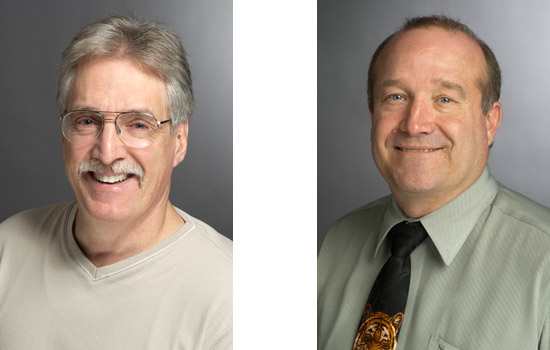RIT’s impact in the semiconductor Industry: Providing the workforce for tomorrow’s technology
Viewpoints By Michael Jackson, Santosh Kurinec and Robert Pearson
Michael Jackson and Robert Pearson
RIT’s microelectronic engineering program has been a unique resource for the worldwide semiconductor industry for the past 30 years, producing engineers who understand integrated-circuit design, simulation, fabrication, testing and manufacturing. In the past two years, RIT’s impact has been seen much closer to home as several influential corporations expanded into New York state.
Global Foundries is installing equipment in its new $6 billion semiconductor plant near Albany, a project whose origins go back 10 years. To attract Global Foundries, New York made a commitment to workforce training by creating the College of Nanoscale Science and Engineering at SUNY Albany. The state also provided some funding to bring SEMATECH, the research arm of the semiconductor industry, to the state capitol.
The workforce pipeline starts in the K-12 arena through a student’s interest in the science, technology, engineering and mathematics fields. Through a National Science Foundation grant to form the Northeast Advanced Technological Education Center, Hudson Valley Community College is reaching out to local high schools and community colleges in eastern New York, Vermont and Massachusetts to increase awareness of careers in advanced manufacturing of microelectronics and nanotechnology. The college turned to RIT’s microelectronic engineering program faculty for assistance and guidance, and later, to provide teacher trainings.
Our faculty conducted training at RIT May 9–10 for 12 high school teachers sponsored by the center to learn more about the field, much of it in our Semiconductor Microsystems Fabrication Laboratory where they were able to utilize the equipment. Recently we went to Saratoga Springs to tour Hudson Valley’s Tec-Smart Center, critique the training and plan future offerings. As a side trip, we visited Global Foundries to meet its University Relations team to discuss potential collaborations. The trip culminated with a private dinner and reception at the recent annual meeting of the World Semiconductor Council May 21–25. The international organization is comprised of the U.S. Semiconductor Industry Association along with its European and Asian counterparts.
RIT’s relationships with all these organizations are contributing to the economic development project known as Tech Valley, a decades-old vision for a high-tech corridor from New York City to Albany. That vision has spread, expanding into western New York—and RIT has made several important contributions.
In 2010, the Center of Excellence in Canandaigua joined with Albany’s College of Nanoscale Science to become the Smart Systems Technology and Commercialization Center. At the center, Moser Baer Technologies has launched a pilot plant to commercialize organic light-emitting-diode lighting panels. The panels represent an environmentally friendly alternative to fluorescent lighting by consuming only a fraction of the power to produce a softer white light. Alumni from microelectronic engineering are employed at the center and Moser Baer facilities, and both will be looking to hire more graduates in the near future.
Genesee County Economic Development Corporation partnered with us to address workforce challenges for advanced, high-tech manufacturing. With the Science and Technology Advanced Manufacturing Park, the county is aggressively working to prepare a suitable site so that in the event another semiconductor company decides to build a multi-billion dollar factory, western New York could be its home. In support of this project, RIT partnered with Genesee County and Genesee County Community College last fall to deliver an 11-week certificate program on advanced manufacturing. This program consisted of lecture time at the college and trips to work in the Kate Gleason College of Engineering and College of Applied Science and Technology labs. As of this writing, two out of three attendees, individuals between 18 and 55, who were either unemployed or under-employed, are back to work.
The current level of activity in New York involving semiconductors and microelectronic engineering is unprecedented. What for decades had been relegated to the IBM campuses around New York City has now created a Tech Valley from New York City to Albany. Success in Albany will in turn extend westward, and one key ingredient to make this vision a reality is a well-trained, highly competent workforce. High school and community college students need to be recruited for STEM careers in advanced manufacturing. At a time when unemployment is a major concern, we have more requests from industry for graduates than we have graduates. The microelectronic engineering program has been creating the workforce for the semiconductor industry for 30 years—and we hope to do it for another 30 years.
Michael Jackson is an associate professor and outreach director, microelectronic engineering; Santosh Kurinec is a professor and IEEE Fellow; and Robert Pearson is program director of the microelectronic engineering program in RIT’s Kate Gleason College of Engineering. “Viewpoints” presents insight and opinions on issues of relevance to RIT or higher education generally.
 Santosh Kurinec
Santosh Kurinec










